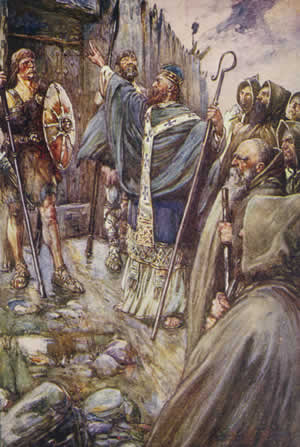
Columba or Colmcille was an Irish abbot and missionary evangelist credited with spreading Christianity in what is today Scotland at the start of the Hiberno-Scottish mission. He founded the important abbey on Iona, which became a dominant religious and political institution in the region for centuries. He is the patron saint of Derry. He was highly regarded by both the Gaels of Dál Riata and the Picts, and is remembered today as a Catholic saint and one of the Twelve Apostles of Ireland.
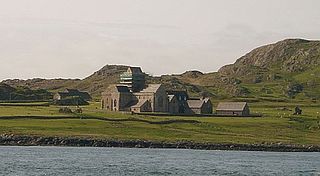
Iona is an island in the Inner Hebrides, off the Ross of Mull on the western coast of Scotland. It is mainly known for Iona Abbey, though there are other buildings on the island. Iona Abbey was a centre of Gaelic monasticism for three centuries and is today known for its relative tranquility and natural environment. It is a tourist destination and a place for spiritual retreats. Its modern Scottish Gaelic name means "Iona of (Saint) Columba".
Óengus mac Fergusa was king of the Picts from 820 until 834. In Scottish historiography, he is associated with the veneration of Saint Andrew, the patron saint of Scotland, although this has not been proven.
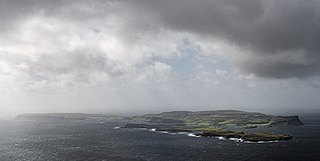
Canna is the westernmost of the Small Isles archipelago, in the Scottish Inner Hebrides. It is linked to the neighbouring island of Sanday by a road and sandbanks at low tide. The island is 4.3 miles (6.9 km) long and 1 mile (1.6 km) wide. The isolated skerries of Hyskeir and Humla lie 6.2 miles (10.0 km) south-west of the island.
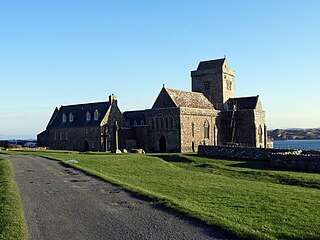
Iona Abbey is an abbey located on the island of Iona, just off the Isle of Mull on the West Coast of Scotland.

Columba de Dunbar was Bishop of Moray from 1422 until his death at Spynie Palace near Elgin sometime before 7 November 1435.

Old Saint Paul's is an historic church of the Scottish Episcopal Church in the heart of Edinburgh's Old Town in Scotland. It is one of the original congregations of the Scottish Episcopal Church, part of the Anglican Communion, which evolved with the adoption of Presbyterian governance by the established Church of Scotland.

Hinba is an island in Scotland of uncertain location that was the site of a small monastery associated with the Columban church on Iona. Although a number of details are known about the monastery and its early superiors, and various anecdotes dating from the time of Columba of a mystical nature have survived, modern scholars are divided as to its whereabouts. The source of information about the island is Adomnán's late 7th-century Vita Columbae.
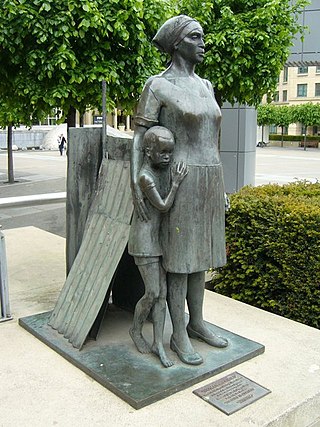
Anne Ross Davidson, DA was a Scottish sculptor and artist. Many of her commissioned works are on public view in Scotland and abroad.
St. Columba's Church, St. Kolumba and similar names may refer to churches dedicated to a saint Columba, hoverever, there are several.

The Monifieth Sculptured Stones are a series of five class II and III standing Pictish stones from the early Medieval period found in or around St Regulus' church in Monifieth, Angus, Scotland. Uncovered during the demolition of a pre-Reformation church and its kirkyard wall in the 19th and 20th centuries, the stones are now housed in the collection of the Museum of Scotland.

St Columba's-by-the-Castle is a congregation of the Scottish Episcopal Church in central Edinburgh, Scotland. The church is located close to Edinburgh Castle, on the south slope of Castle Hill, and is protected as a category B listed building.
Peter MacGregor Chalmers LLD was a Scottish architect specialising in country churches, and also being involved in several important restoration schemes.
St Columba's Church, Edinburgh is a Roman Catholic church located in the Newington district of Edinburgh, Scotland.

St Columba's Church is a Category B listed building on the isle of Canna, in the Small Isles, Highland, Scotland.

St Edward's Church, Sanday, is a deconsecrated, and now disused church on the small isle of Sanday, Inner Hebrides, Scotland.

Margaret Fay Shaw was a pioneering Scottish-American ethnomusicologist, photographer, folklorist, and scholar of Celtic studies. She is best known for her meticulous work as a folk song and folklore collector among Scottish Gaelic-speakers in the Hebrides, Canadian Gaelic-speaking communities in Nova Scotia, and among Connaught Irish speakers in the Aran Islands.

St Boniface's Church, Papa Westray is a historic church and graveyard located on the island of Papa Westray in Orkney, Scotland. The site of the church dates back to the Iron Age and was possibly used later as a Christian monastery. The present church was built in the 12th century and was remodeled in 1710. A 12th-century Norse hogback gravestone lies to the east of the church. Two Pictish cross-slabs were uncovered in the graveyard in the 20th century, and were later moved to museums. Historic Environment Scotland established the site as a scheduled monument in 1959.

The Highland Church was a Gaelic-speaking congregation of the Church of Scotland, based in Tollcross, Edinburgh. Formed by the union of St Oran's Church and St Columba's Gaelic Church in 1948, the congregation continued united with Tolbooth St John's in 1956.
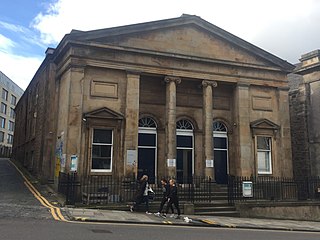
St Oran's Church was a Gaelic-speaking congregation of the Church of Scotland in Edinburgh. Originating in the early 18th-century, the congregation continued until 1948, latterly meeting at Broughton Street.

















